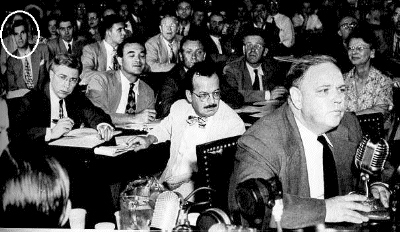
Alger Hiss (circled) listens as Whittaker Chambers testifies before a HUAC meeting on August 25, 1948.
No criminal case had a more far-reaching effects on modern American politics than the Alger Hiss-Whittaker Chambers spy case which held Americans spellbound in the middle of the twentieth-century. The case catapulted an obscure California congressman named Richard Nixon to national fame, set the stage for Senator Joseph McCarthy's notorious Communist-hunting, and marked the beginning of a conservative intellectual and political movement that would one day put Ronald Reagan in the White House.
Even without its important influence on American political debate, the trials of Alger Hiss for perjury have the makings of a great drama. They featured two men who could hardly be more different, sharing only impressive intelligence. Alger Hiss was a tall, handsome Harvard-trained lawyer with an impeccable pedigree. Whittaker Chambers was a short, stocky, and rumpled Columbia drop-out and confessed former Communist from a poor and troubled Philadelphia family. Time and time again the two men would tell flatly contradictory stories about Hiss's allegiances during the period from 1933 to 1938 to congressional committees. trial juries, and the reading public. Hiss, according to Chambers, was a dedicated Communist engaged in espionage, even while working at the highest levels of the United States government. Hiss told a very different story, claiming unflinching loyalty and denying even membership in the Communist Party. One man was lying, one was telling the truth.
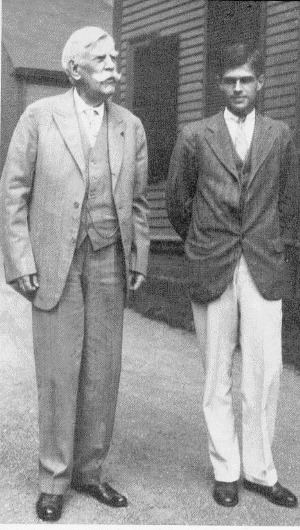
Oliver Wendell Homes with Alger Hiss in 1930 (John Knox photo)
In the summer of 1948, Chambers's story rang true to one very important young man: Congressman Richard Nixon, a member of the House Un-American Activities Committee, then an often-ridiculed political backwater.
The House Un-American Activities Committee Hearings of 1948
Whittaker Chambers did not want to testify before the House Un-American Activities Committee (HUAC) in August 1948, but saw it as his patriotic duty. In his 1952 autobiography, Witness, Chambers wrote, "I prayed that, if it were God's will, I might be spared that ordeal." At the same time, he sensed that testifying about his past role as a Communist agent was the event for which "my whole life had been lived." Chambers believed that "the danger to the nation from Communism had now grown acute," threatening his country's very existence.
On August 3, in the hearing room of the Ways and Means Committee, forty-seven-year-old Chambers told Committee members that he left the Communist Party in 1938, and the next year--"two days after Hitler and Stalin signed their pact"--he "went to Washington and reported to authorities what I knew about the infiltration of the United States Government by Communists." Remarkably, little was done to follow up on Chambers's reports of extensive Communist infiltration. Chambers identified for the Committee persons who he had nine years before reported as being active in the Communist underground:
The head of the underground organization at the time was I knew it was Nathan Witt, an attorney for the National Labor Relations Board. Later, John Abt became the leader. Lee Pressman was also a member of this group, as was Alger Hiss, who, as a member of the State Department, later organized the conference at Dumbarton Oaks, San Francisco, and the United States side of the Yalta Conference.
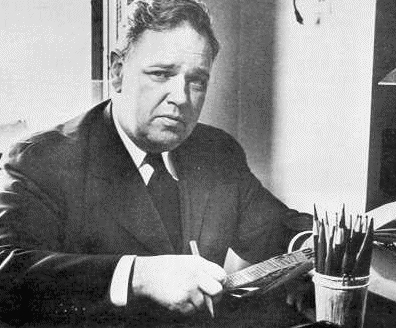
Whittaker Chambers in 1939
Questioned by Committee Investigator Robert Stripling about his association with Alger Hiss, then President of the Carnegie Endowment for International Peace and a well-respected national figure, Chambers described a close friendship that included time in the Hiss home with Alger and his wife, Priscilla. Chambers told of a final meeting at the Hiss home when he tried to convince Alger Hiss to leave the party. Chambers testified, "He cried when we separated, when I left him, but he absolutely refused to break....I was very fond of Mr. Hiss." Congressman Mundt asked Chambers what reasons Hiss gave for refusing to break with the Communists. "His reasons were the party line," replied Chambers.
Chambers's accusations receoved large play in the media. Hiss decided he could not ignore the charges. In what proved to be a monumental mistake, he sent a telegram to HUAC's chairman, J. Parnell Thomas, categorically denying the charges. Hiss's telegram said,
I DO NOT KNOW MR. CHAMBERS AND, SO FAR AS I AM AWARE, HAVE NEVER LAID EYES ON HIM. THERE IS NO BASIS FOR THE STATEMENTS ABOUT ME MADE TO YOUR COMMITTEE....I WOULD FURTHER APPRECIATE THE OPPORTUNITY OF APPEARING BEFORE YOUR COMMITTEE...
Hiss's wish for an opportunity to appear before HUAC was granted. On August 5, before a packed house, Hiss calmly and confidently told Committee members, "I am not and never have been a member of the Communist Party." He repeated the statement in his telegram that he had "never laid eyes on" Chambers, and added "I would like to have the opportunity to do so." Hiss's performance was impressive enough to convince most members of the Committee that the investigation should be dropped. President Truman called the Capitol Hill spy inquiry "a red herring." HUAC was under fire.
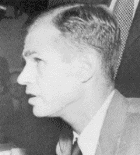
Hiss at his first hearing (August 5, 1948)
One member of the Committee, however, wanted to press on with the investigation. Congressmen Richard Nixon had accepted a seat on the House Un-American Activities Committee in 1947, at a time when HUAC was an often-ridiculed political backwater. He thought Chambers' charges rang true and found Hiss "condescending" and "insulting in the extreme." To many observers, it was Hiss's Eastern Ivy League pedigree and style that offended Nixon, a Whittier College graduate and the product of working-class parents. With some reluctance, the Committee voted to make Nixon chair of a subcommittee that would seek to determine who was lying, Hiss or Chambers, at least on the question of whether they knew each other. HUAC soon became the most talked-about committee in Congress.
On August 7, Nixon's subcommittee met Chambers at the Federal Court House in New York City to pursue its investigation into the confessed spy's association with Alger Hiss. Nixon asked many questions designed to determine whether he knew the things about Hiss that he should "if he knew him...as well as he claimed." Chambers had most of the answers on such subjects as nicknames, habits, pets, vacations, mannerisms, and descriptions of floor plans and furniture. On the question of whether Hiss had any hobbies, Chambers gave an answer that would soon haunt Hiss:
Yes, he did. They both [Alger and Priscilla Hiss] had the same hobby--amateur ornithologists, bird observers. They used to get up early in the morning and go to Glen Echo, out the canal, to observe birds. I recall once they saw, to their great excitement, a prothonotary warbler.
Hiss faced more hostile questioning from the Committee in executive session on August 16. Stripling pointedly observed that either Chambers has "made a study of your life in great detail or he knows you." After being shown two photographs of Chambers, Chairman Thomas asked Hiss whether he still maintained that he did not recognize the man who claimed to have spent a week in his house. Hiss answered, "I do not recognize him from that picture...I want to hear the man's voice." After a morning recess, Hiss announced that he now believed that his accuser might be a man he knew in the mid-1930s as "George Crosley," a free-lance writer who he said sought out information about Hiss's work on a congressional committee dealing with the munitions industry. Crosley's most memorable feature, according to Hiss, was "very bad teeth."
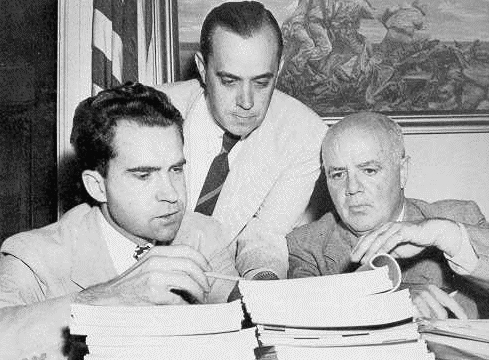
HUAC committee member Richard Nixon, investigator Robert Stripling, and Chairman Thomas examine Hiss files
A turning point in the investigation came when Richard Nixon asked, "What hobby, if any do you have, Mr. Hiss?" Hiss answered that his hobbies were "tennis and amateur ornithology." Congressman John McDowell jumped in: "Did you ever see a prothonotary warbler?" Hiss fell into the trap, responding, "I have--right here on the Potomac. Do you know that place?" In discussions after the hearing, Committee members indicated they were now convinced Hiss was lying, based in large part on the response about the warbler. It seemed to Stripling and others very unlikely that Chambers could have known about such a detail through a general study of Hiss's life. It had to be firsthand knowledge.
At an August 17 HUAC hearing, Hiss met his accuser. Nixon asked both Chambers and Hiss to stand. Then he said to Hiss, "I ask you now if you have ever known that man before?" Turning to Chambers, Hiss (who had minutes before asked Chambers to open his mouth so that he could look at his teeth) asked, "Are you George Crosley?" Chambers replied, "Not to my knowledge. You are Alger Hiss, I believe." Hiss told the Committee Chambers was probably the man he knew as Crosley, but proceeded to ask some questions of Chambers designed, he said, to remove his remaining doubts. Finally, after a series of questions that mostly backfired, Hiss announced, "I am now perfectly prepared to identify this man as George Crosley." After a number of tough questions from the Committee to Hiss, the tense session ended with Chairman Thomas saying, "That is all. Thank you very much." Hiss replied testily, "I don't reciprocate."
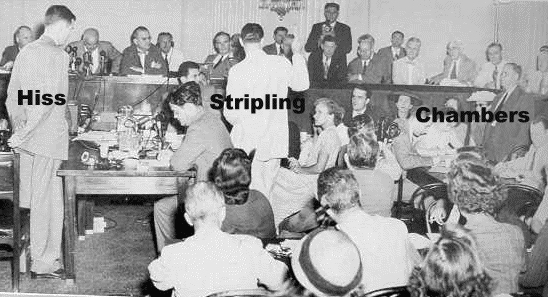
Hiss is asked to identify Chambers at August 17, 1948 session
On August 25, for the first time in history, television cameras were present for a congressional hearing. The Committee was well armed, and confronted Hiss with a host of questions about an alleged lease of Hiss's apartment to Chambers and a simultaneous transfer to Chambers of Hiss's old 1929 Ford. Congressman Hebert, reflecting the Committee's skepticism of Hiss's answers, wondered aloud about a person of Hiss's "intellect...who gives to casual people his apartment [and] who tosses in an automobile." In the afternoon session, Chambers called Hiss a "devoted and at the time a rather romantic Communist" who now "represents the concealed enemy against which we are all fighting, and I am fighting."
On August 27, HUAC published a report in which it called Hiss's testimony "vague and evasive." As for the testimony of Chambers, the Committee called it "forthright and emphatic." In response, Hiss published a fourteen-page letter attacking HUAC for "using the great powers and prestige of the United States Congress to help sworn traitors to besmirch any American they may pick upon."
The Pumpkin Papers
On October 8, Hiss filed a slander suit against Chambers, based on his accusation on Meet the Press that Hiss "was a Communist and may be now." Hiss's attorneys began a widespread investigation into the background of Chambers in hopes of destroying his credibility. The investigation included exploration of whether Chambers had ever been treated for mental illness or entered into homosexual relationships. (In fact, Chambers had engaged in a number of homosexual affairs in the mid-1930s, but defense attorneys were unable to ferret out this piece of information which might have been useful in establishing a motive for Chambers's alleged lies.)
In the middle of a deposition of Chambers in preparation for the slander suit, Hiss's attorney, William Marbury, requested that Chambers produce "any correspondence, either typewritten or in handwriting from any member of the Hiss family." Shortly after that request, Chambers visited the Baltimore home of his nephew's mother where, he said, he reached into a dumbwaiter shaft in the bathroom and pulled out a large, weathered envelope. The envelope contained four notes handwritten by Alger Hiss, sixty-five typewritten documents (copies of State Department documents, all dated between January and April, 1938) and five strips of 35 mm film. The documents, if genuine, were strong evidence not only that Hiss knew Chambers long after mid 1936, when Hiss claimed to have last seen "Crosley," but also that Hiss engaged in espionage.
Chambers turned over the documents to his lawyers, keeping the film. When Marbury resumed his deposition of Chambers, Hiss's bewildered attorney found himself presented with a packet of documents that not only blew his client's slander suit out of the water, but placed Hiss in serious danger of a criminal indictment.
The revelation of the Baltimore papers also stunned HUAC members and investigators. Chambers explained his delay in producing the incriminating documents as an effort to spare an old friend more trouble than necessary. He said he produced the drs also stunned HUAC members and investigators. Chambers explained his delay in producing the incriminating documents as an effort to spare an old friend from more trouble than necessary. The investigation accompanying Hiss's slander suit, however, convinced Chambers that "Hiss was determined to destroy me--and my wife if possible," making disclosure seem the better course. Chambers also may have recognized that if he lost in the slander case, he might well have faced a Justice Department prosecution.
There was still one more big shoe to drop. Chambers placed the film (two strips developed and three undeveloped) taken from the Baltimore home into a hollowed-out pumpkin, then placed the pumpkin back in a pumpkin patch on his Maryland farm. On the evening of December 2, 1948, Chambers accompanied two HUAC investigators to his farm, then led him to the patch holding the hollowed-out pumpkin. The film would prove later to include photographs of State and Navy Department documents. Over the ensuing months of the Hiss-Chambers controversy, the press--enjoying the alliteration--would generally refer to the entire set of documents and photographs taken from Baltimore as "the pumpkin papers." The following day, Hiss released a statement promising his "full cooperation to the Department of Justice and to the grand jury in a further investigation of this matter."
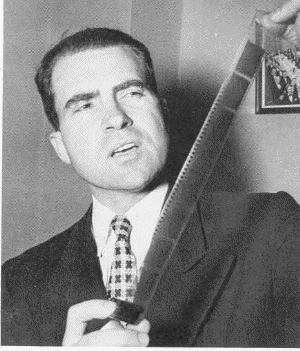
Nixon examines film found in pumpkin
The Pumpkin Papers changed everything. The question of whether Hiss knew Chambers better than he admitted, or even whether he was a Communist, now seemed relatively inconsequential. The question now was whether Alger Hiss, high State Department official, was a Soviet agent. Fortunately for Hiss, the statute of limitations for espionage was five years, and the incriminating evidence all concerned documents passed over a decade earlier. The statute of limitations was not an issue, however, on the question of whether Alger Hiss committed perjury.
The First Perjury Trial
Forty-four-year-old Alger Hiss, wearing a gray herringbone suit, blue tie, and a brimmed brown hat, entered the Federal Courthouse in Manhattan on May 31, 1949 for the first day of his trial for perjury. Hiss faced two counts, both stemming from testimony before a federal grand jury the previous December. Hiss was charged with lying when he testified that he never gave any documents to Whittaker Chambers and when he claimed never to have seen Chambers after January 1, 1937.
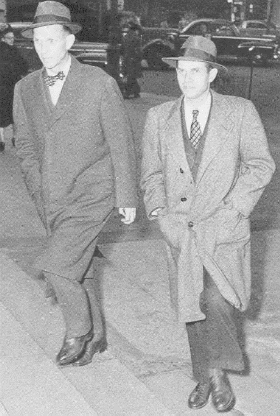
Hiss, with his brother Donald, arrives at courthouse to testify before grand jury
In his opening statement, Assistant U. S. Attorney Thomas Murphy told the twelve-person, middle-class jury, selected after questioning by Judge Samuel H. Kaufman, "If you don't believe Chambers, then we have no case." Murphy said the prosecution had no "photographs of the man lying," but would instead "corroborate Chambers's testimony by the typewriting and the handwriting." He predicted that after the evidence is presented the jury "will be convinced as I am that he is telling the truth."
Defense attorney Lloyd Paul Stryker, in his opening statement, said his client welcomed the "quiet and fair court of justice" after "the days of the Klieg lights, the television, and all the paraphernalia, the propaganda which surrounded the beginning of this story." Stryker said that the trial would show the contrast between his client, without a "blot or blemish on him," and Chambers, "a voluntary conspirator against the land that I love and you love."
Whittaker Chambers was, of course, the prosecution's central witness. Chambers testified that Hiss began passing him State Department documents in early 1937. He described Soviet agent Colonel Boris Bykov's recommended espionage procedures, followed by Hiss, that included bringing files home nightly and retyping them. Chambers identified the famous documents, both the typewritten and those in Hiss's own hand, and said that they had been given to him by Hiss in his Washington home.
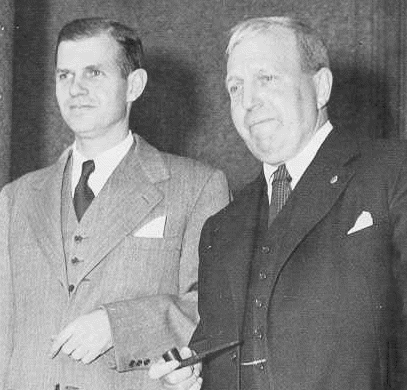
Defense attorney Stryket with Hiss
On cross-examination, Stryker tried to highlight defects in Chambers's character. He asked about a play, written by Chambers as a student at Columbia in 1924, that Stryker called "an offensive treatment of Christ." He asked whether he ever lived in a "dive" in New Orleans with a prostitute named "One-Eyed Annie." (Chambers denied the charge.) He demanded to know whether Chambers was "for some fourteen years an enemy and traitor of the United States of America?" Chambers answered, "That is right." Styker pressed Chambers on why he hadn't, knowing what he claimed to know, warned the President or anybody before 1948 that Hiss should not be trusted in the important positions that he held. Styker suggested that the timing of Chambers's charge was an attempt to help the Republican Party's campaign against Truman.
Chambers's wife, Esther, followed Whittaker to the stand. She told jurors of the close relationship that she and her husband enjoyed for several years with Alger and Priscilla Hiss--a relationship that she said extended well beyond the January 1, 1937 date that Hiss had told the grand jury was his last meeting with Chambers. She described the Hiss's visit to their Baltimore apartment in December 1937 to celebrate the Hiss's wedding anniversary. The Hiss's, Esther Chambers testified, "brought a bottle of champagne."
Following the testimony from the Chambers came a series of witnesses who tied Alger Hiss to the typewritten State Department documents introduced by the government. Nathan Levine described the visit of Chambers to his mother's home to retrieve the envelope bearing documents from a dumbwaiter shaft. HUAC investigator Donald Appel told the jurors of the visit to the Chambers farm to retrieve "the pumpkin papers." State Department records expert Walter Anderson explained the significance of each of the typewritten papers and handwritten notes alleged to have come from Hiss. Eunice Lincoln, a secretary in Hiss's office, testified that Hiss often took departmental documents home to work on. The most critical testimony tying Hiss to the typed copies of State Department documents came from FBI laboratory expert Ramos C. Feehan. Feehan told jurors that letters known to have been typed by Hiss in 1936 and 1937 ("Hiss standards") were typed on the same Woodstock typewriter as the sixty-five papers found in the Baltimore dumbwaiter shaft. He based his conclusion on similarities between certain letters, such as the lowercase "g," on both sets of papers.

Woodstock typewriter
The defense, through its witnesses, tried to persuade jurors of three things: first, that Hiss's reputation was so good as to make his alleged espionage activity almost unthinkable; second, that Chambers was mentally unstable and should not be believed and, third, that Hiss's Woodstock typewriter had been given to a household employee sometime before 1938, making it impossible for either Alger or Priscilla Hiss to have typed the Baltimore documents.
Three members of the Catlatt family testified that the Woodstock typewriter on which the Baltimore papers were allegedly typed was in fact in their possession, not the Hiss's, in early 1938. Claudia Catlatt thought she received the machine in mid-1936. Mike Catlatt recalled that the typewriter "was broke...the keys would jam up on you," but on cross-examination could not remember getting the machine repaired or when the family got it from the Hiss's. Perry Catlatt placed the time of the gift of the typewriter as December 1937 and recalled taking it soon thereafter to a "repair shop at K Street just off Connecticut Avenue." Prosecutor Murphy effectively undermined Perry Catlatt's credibility when he asked on cross, "Supposing I tell you that the Woodstock repair shop at Connecticut and K did not come into existence until September of 1938?"
Rarely has a defense team ever assembled so impressive a batch of character witnesses as appeared on behalf of Alger Hiss. The list included two U. S. Supreme Court justices, a former Solicitor General, and both former (John W. Davis) and future (Adlai Stevenson) Democratic presidential nominees. Justice Felix Frankfurter described Hiss's reputation as "excellent." Justice Stanley Reed said of Hiss's reputation, "I have never heard it questioned until these matters came up."
On June 23, Alger Hiss took the stand. He admitted writing the four handwritten notes produced by Chambers, but denied any connection with the microfilm found in Chambers's pumpkin or any role in the typing of the sixty-five State Department documents. He also insisted--as he had told the grand jury in December--that he had not met Chambers on any occasion after January 1, 1937. As for the Woodstock typewriter, Hiss's "best recollection" was that he gave it to the Catlatts "in the fall of 1937." On cross-examination, Murphy focused on bringing out numerous inconsistencies between Hiss's trial testimony and his earlier statements.
The testimony of Priscilla Hiss did more harm than good to the defense case. She admitted typing the four "Hiss standards" used for comparison purposes by the FBI with the Baltimore documents. After Priscilla denied that she was a member of the Socialist Party in 1932, Murphy pulled out a voter-roll page that showed her Socialist registration. She struggled to explain her statement to the Grand Jury that the typewriter "may" have been given to the Catlatt's as late as 1943.
Stryker spared nothing in his attack on Whittaker Chambers in his summation to the jury. He called Chambers "an enemy of the Republic, a blasphemer of Christ, a disbeliever in God, with no respect for matrimony or motherhood." Hiss, on the other hand, was "an honest...and falsely accused gentleman." He closed by expressing confidence that for his client, Alger Hiss, "this long nightmare is drawing to a close."

Prosecutor Thomas Murphy
Murphy told the jurors that their duty was clear. The evidence left "only one inference" that could be drawn: "that the defendant, that smart, intelligent, American-born man gave [the secret State Department document] to Chambers." He ended his summation by asking the jurors to "come back and put the lie in that man's face."
On July 6, 1949, the case went to the jury. Late the next afternoon, the jury sent a note saying it "is unable to agree at a verdict." Judge Kaufman urged the jury to make one final effort to reach a conclusion, but within hours the jury again reported itself hopelessly deadlocked. Judge Kaufman reluctantly declared a mistrial. Quizzed about the deliberations, jurors revealed that the final vote stood eight for conviction, four for acquittal. The four jurors in the minority believed that someone other that Alger or Priscilla Hiss typed the documents on Woodstock N230099 .
The Second Perjury Trial
The months between the end of the first Hiss trial and the start of the second had been eventful. The Soviet Union had exploded an atomic bomb. The Red Army of Mao Tse-tung had succeeded in driving the forces of Chiang Kai-shek to the island of Formosa. The NATO treaty had been approved. And, perhaps most ominously for Alger Hiss, polls showed public attitudes shifting towards harsher treatment of U. S. Communists.
The second trial began with a somewhat changed cast. Murphy was back as prosecutor, but Claude Cross now led the Hiss defense. Kaufman, criticized for his pro-defense rulings in the first trial, had been replaced on the bench Henry W. Goddard.
The prosecution produced one major new witness who Kaufman had barred from testifying in the first trial. Hede Massing, a former Soviet agent, testified that he met Alger Hiss at a Communist cell meeting in a private home in 1935. Massing said she recalled arguing with Hiss over whether Noel Field, a State Department spy, should work with her group or with his.
Julian Wadleigh, a bit player in the first trial, became the target of a heavy cross-examination by Cross in the second trial. Cross suggested that it was Wadleigh (a confessed espionage agent) and not Hiss, who supplied the typewritten documents to Chambers--after perhaps having stolen them from a State Department office. There were, however, major problems with this suggestion. First, the defense theory required Wadleigh to also have stolen--on four separate occasions--Hiss's handwritten notes. Second, the theory meant that Wadleigh, after having stolen the documents from the State Department, would have had to successfully return them to their proper place.
The defense case in the second trial placed heavy reliance on the testimony of its expert psychiatrist, Dr. Carl A. Binger. On direct examination, Dr. Binger (based on his reading of Chambers's writings and his observation of his trial testimony) called Chambers a "psychopathic personality" and "a pathological liar." However, in one of the most famous and devastating cross-examinations in courtroom history, Murphy destroyed Binger's credibility. One commentator said admiringly, "Mr. Murphy just wanted plain answers to plain questions--about the most alarming assignment anyone would wish on a psychiatrist." Murphy, through his questions, suggested that the label "psychopathic personality" was useless and empty catch-all of a lot of symptoms. Noting, for example, that Binger had concluded that the tendency of Chambers to look up at the ceiling from the witness chair was a symptom of a psychopathic personality, Murphy asked what should be made of the fact that Murphy's assistant prosecutor had counted Binger eyeing the ceiling fifty times in less than an hour of his own testimony. Murphy asked about another alleged symptom of Chambers's psychopathic personality: his "untidiness" and lack of concern about his appearance. Murphy wondered whether other famous persons well-known for untidiness or haphazard dress, such as Albert Einstein, Bing Crosby, and Thomas Edison, were, therefore, psychopaths? Murphy countered Binger's argument that the equivocations of Chambers during his testimony was a sign of a psychopathic personality by quizzing the doctor about what conclusion one should draw from 158 equivocations by Alger Hiss in his 550 pages of testimony. Murphy also attacked Binger's conclusion that hiding microfilm in a pumpkin was indicative of a psychopathic personality. Murphy asked whether that meant other famous hidings, including "the mother of Moses hiding the little child in the bulrushes," was symptomatic of a serious personality disorder?
With more witnesses and more latitude allowed for questioning, the second trial took three weeks longer than the first. In his summation, Cross conceded that the stolen documents had been typed on the Woodstock once owned by Hiss, but told jurors that "it is not the question of what typewriter was used, but who the typist was." Cross suggested that somehow Chambers or a confederate might have gotten hands on the typewriter after it left the possession of the Hiss's and typed the documents in an effort to frame Alger. Murphy, in closing for the prosecution, stressed the mountain of "immutable" evidence suggesting a close relationship once existed between Chambers and Hiss. Murphy told jurors that the Chambers-Hiss friendship and the typed and handwritten documents proved Hiss a "traitor" who "was in love with their philosophy, not ours."
The jury returned its verdict on the afternoon of January 20, 1950: "We find the defendant guilty on the first count and guilty on the second." Alger Hiss, who had "high hopes" for an acquittal, sat quietly with his wife as Judge Goddard thanked the jury for their "just verdict." Five days later, the judge imposed the maximum sentence of five years. Before he did so, Hiss made a brief statement in which he expressed confidence "that in the future the full facts of how Whittaker Chambers was able to carry out forgery by typewriter will be disclosed."
Trial Aftermath
On December 7, 1950, the Second Circuit Court of Appeals affirmed Hiss's conviction. Three months later, by a vote of four to two, the Supreme Court declined to review the case. (Justices Black and Douglas voted to grant cert. Justices Frankfurter, Reed, and Clark all voted to disqualify themselves, based on connections either to Hiss or the case.) Days after the Supreme Court's decision, Hiss began his five-year sentence for perjury at Lewisburg Federal Penitentiary in Pennsylvania. He served forty-four months before being released for good behavior.
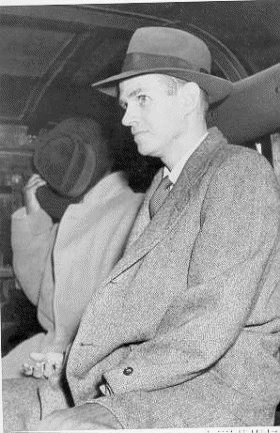
Hiss on his way to prison
The Hiss case set in a motion a chain of events that would forever change American politics. Joseph McCarthy, a little-known senator from Wisconsin, seized on the Hiss conviction to charge that the Department of State was "thoroughly infested" with Communists. Soon he would begin divisive hearings--the controversial "witch-hunt." (Chambers disassociated himself with McCathy's crusade, saying "For the Right to tie itself in any way to Senator McCarthy is suicide. He is a raven of disaster.") Richard Nixon's sudden fame from his role in the Hiss-Chambers attention led the 1952 Republican nominee for President, General Dwight Eisenhower, to select him as his running mate. Most significantly, Chambers fanned the anti-Communist embers that within a decade evolved into a grassroots conservative movement in the Republican Party that, in 1964, produced the nomination of Barry Goldwater and, in 1980, the election of Ronald Reagan. It is often forgotten what Lionell Trilling observed about political thought in America before the Hiss case: "In the United States at this time liberalism is not only the dominant but even the sole intellectual tradition."
The lasting influence of Whittaker Chambers on American politics came not just from the hearings and the subsequent perjury trial. In 1952, Chambers published a remarkable autobiography, Witness, that even so different a person as Arthur Schlesinger, Jr. would call one of the greatest of all American autobiographies. Chambers wrote of a contest between two great faiths, by which he meant Communism and Freedom. "Two faiths were on trial," Chambers said, "and human societies, like human beings, live by faith and die when faith dies."
Sidney Hook, reviewing Witness in the New York Times wrote, "It throws more light on the conspiratorial and religious character of modern Communism, on the tangled complex of motives which led men and women of goodwill to immolate themselves on the altar of a fancied historical necessity, than all of the hundred great books of the past combined." Ronald Reagan credited Chambers's book as leading to his own transformation from a New Deal Democrat to a conservative Republican. Throughout his political career, Reagan made repeated references to Chambers in his speeches. Reagan said Chambers sparked "the counterrevolution of the intellectuals" and that Chambers's story "represents a generation's disenchantment with statism and its return to eternal truths and fundamental values." On March 26, 1984, Chambers (who died in 1961) posthumously received from President Reagan the nation's highest honor, the Medal of Freedom.
Alger Hiss, in the forty-six years he lived after his perjury conviction, never departed from his claim of innocence. Even after the release in the mid-1990s of the Venona cables, intercepted communications from Soviet agents in the United States to Moscow that seem to identify Hiss ("ALES") as a Soviet agent who continued to support the Communism cause through his work at the 1945 Yalta Conference, many of Hiss's supporters remained unpersuaded of his guilt.
Writing in the New York Observer in 2001, Ron Rosenbaum offered a theory for what Leslie Fiedler called "the half-deliberate blindness of so many decent people." Rosenbaum noted that Hiss's supporters often cite as a reason for their belief in his innocence the very fact that Hiss continued to insist upon his innocence and encourage "generations of researchers, volunteers, and true believers...to devote a good part of their lives to him and his cause." Rosenbaum offered this summary of their central argument: "You don't think that he would have gotten all these people to work on the case if he wasn't innocent?" Rosenbaum's own explanation for Hiss's refusal to admit guilt was quite different. Rosenbaum saw Hiss as "proud" of having maintained his innocence, even if it meant "stringing along his well-meaning defenders," because he still believed the cover-up of his work for the Soviets was "a principled necessity."
The confrontation between Chambers and Hiss contributed to a polarization of the political left and political right. Chambers saw the world as a battlefield between godless Communists and Christian anti-Communists. A battle between darkness and light. Liberals largely rejected that division, seeing it as arrogant and overly simplistic. Where you stood determied what you saw.
